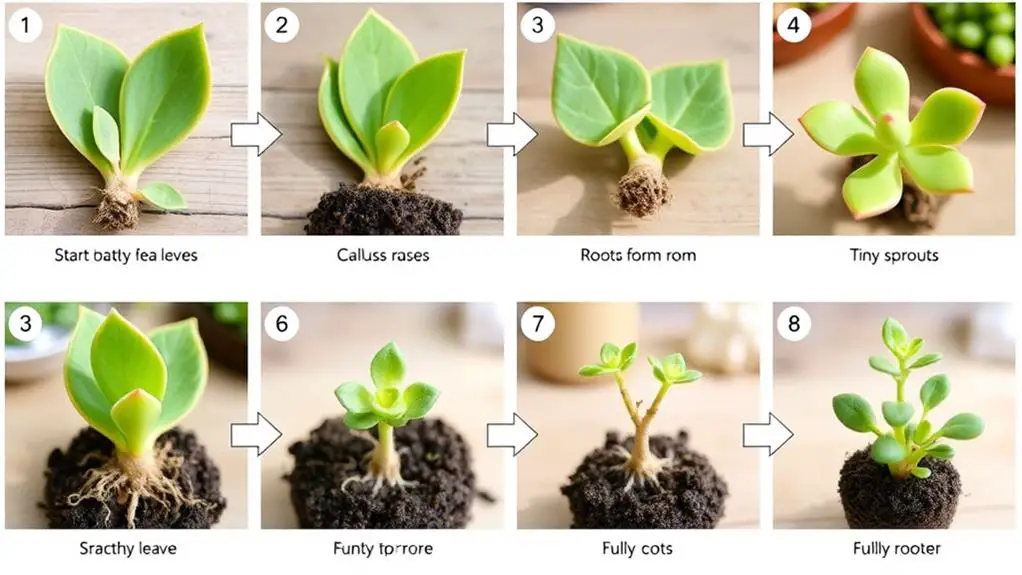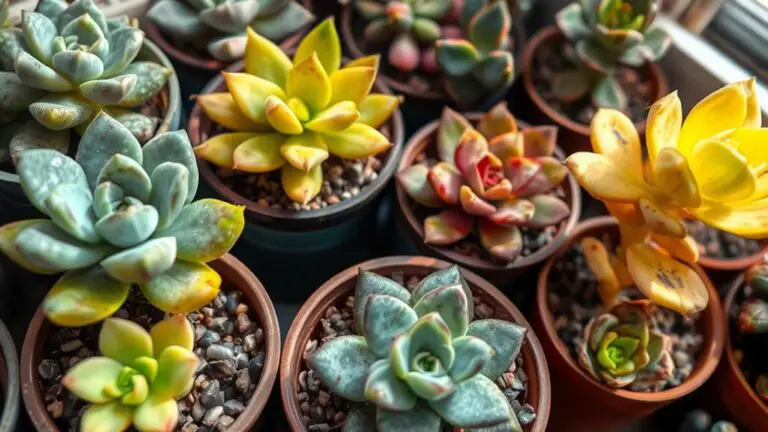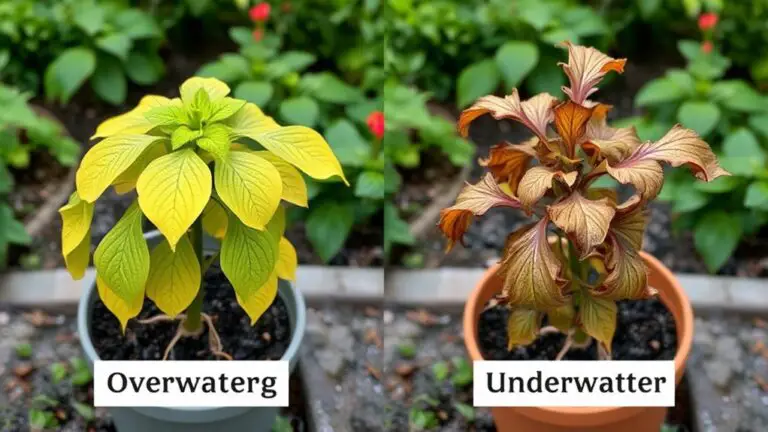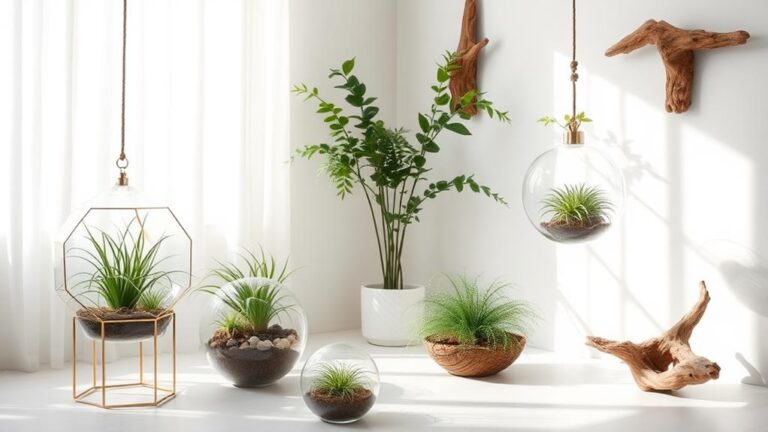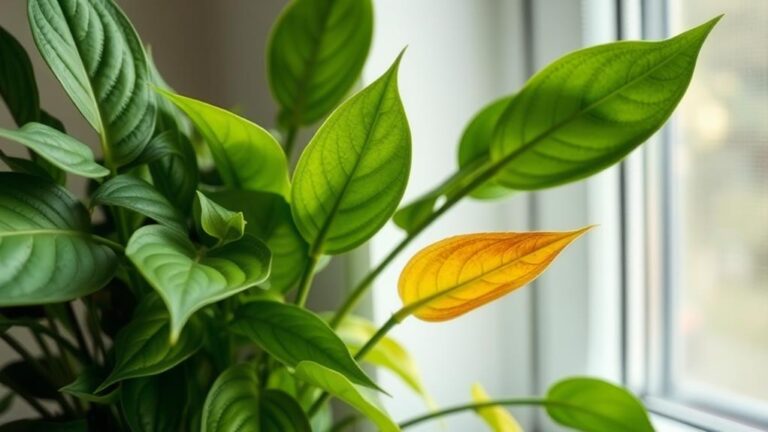7 Steps for Successful Succulent Leaf Propagation With a Week-By-Week Breakdown
If you've ever wanted to grow your succulent collection without buying more plants, leaf propagation is a rewarding method. You'll need to follow a systematic approach, starting with gathering the right tools and choosing healthy leaves. From there, you'll let the leaves callous, prepare a well-draining soil mix, and carefully place the leaves on top. As the weeks go by, maintaining consistent moisture and monitoring light conditions will be essential. But what happens once roots start forming? Stick around to uncover the final steps and guarantee your new succulents thrive.
Gather Essential Tools
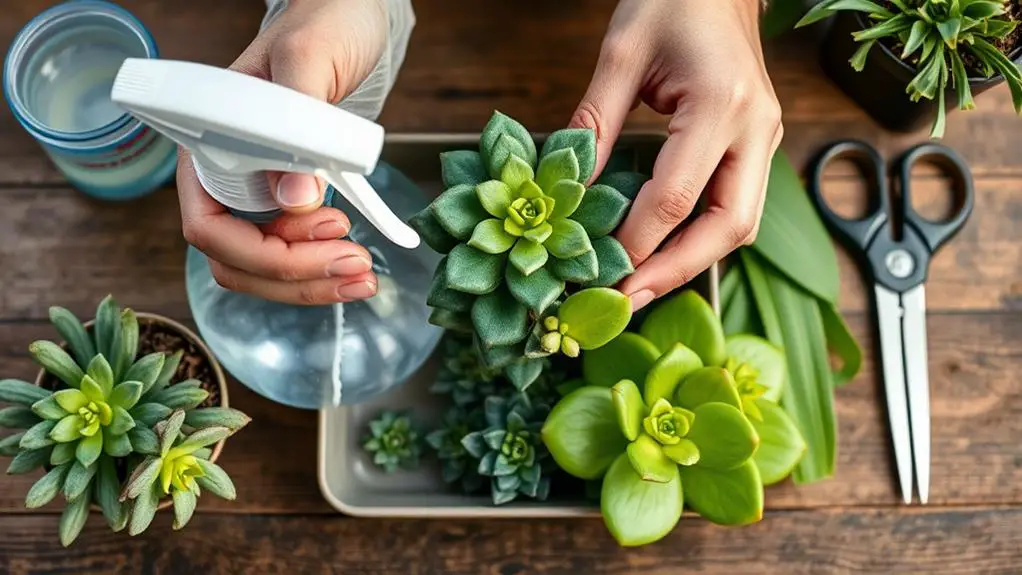
To successfully propagate succulent leaves, you need to gather a few essential tools. First, find a small tray like a metal baking tin or a terra cotta saucer. This will hold your cuttings during the propagation process. These trays help keep everything organized and prevent the leaves from rolling away.
Next, you'll need the right soil. Succulent or cactus soil works best because it guarantees proper drainage and supports healthy growth. Regular potting soil holds too much water and can cause your cuttings to rot. Good soil is vital for the leaves to develop roots.
A fine spray bottle is another must-have tool. It allows you to moisten the soil without overwatering. Overwatering can be harmful to your cuttings, so this tool helps you keep the moisture level just right.
When you gather all these tools, you're setting yourself up for success. Don't forget, collecting multiple leaf cuttings increases your chances of successful propagation. More cuttings mean more opportunities for new plants.
Select Healthy Leaves
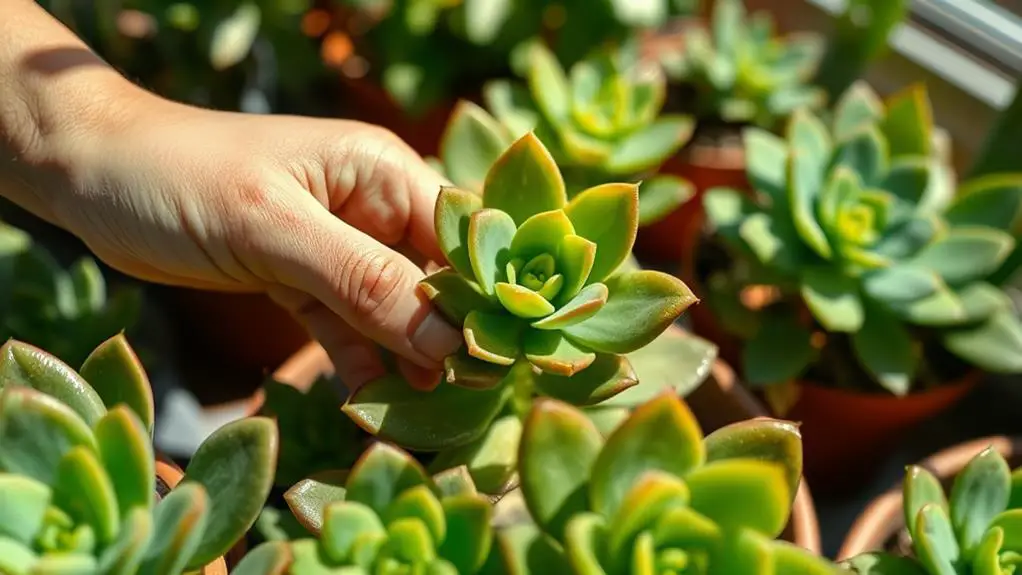
To start, pick healthy leaves from the bottom of your succulent since these are usually mature and perfect for propagation.
Look for leaves that are plump and free of any spots or tears.
Gently twist them off near the stem base, then let them callous for a few days to heal and reduce rot risk.
Optimal Leaf Characteristics
Selecting the right leaves is essential for successful succulent propagation. You'll want to choose mature, healthy leaves from the bottom of the plant. These leaves are typically plump and uniformly colored, which means they're in prime condition for the propagation process. Avoid damaged or discolored leaves as they're less likely to root successfully.
Here's a quick table to help you identify ideal leaf characteristics:
| Leaf Characteristic | Description | Importance |
|---|---|---|
| Maturity | Select mature leaves | Better rooting and propagation |
| Health | Plump, uniformly colored | Higher success rate |
| Damage | Free from tears or discoloration | Reduces risk of rot |
| Location | Bottom of the succulent | Best propagation |
Once you have your healthy leaves, it's essential to use the proper removal technique. Gently pinch and twist the leaf at the stem to keep the end intact. After removing the leaf, let it dry and callous for 3-7 days in indirect sunlight. This callousing step is critical to prevent rot and promote successful rooting.
Ideal Removal Technique
Mastering the ideal removal technique is vital for successful succulent propagation. To start, focus on selecting mature, plump leaves that are free from wrinkles or damage. These mature leaves have the best chance of thriving.
Avoid immature, discolored, or torn leaves, as they're less likely to propagate successfully.
When you're ready to remove a leaf, gently pinch and twist it at the base. This guarantees a clean break and keeps the stem end intact. An intact stem end is significant because it allows the leaf to callous properly, which is necessary for healthy root development.
Select leaves from the lower part of the mother leaf plant, as these are usually healthier and more developed.
Once you've removed a healthy leaf, place it in a dry area with indirect sunlight. Let the cut end dry and callous for 3-7 days. This step is important to prevent rot and promote healthy roots.
Allow Leaves to Callous
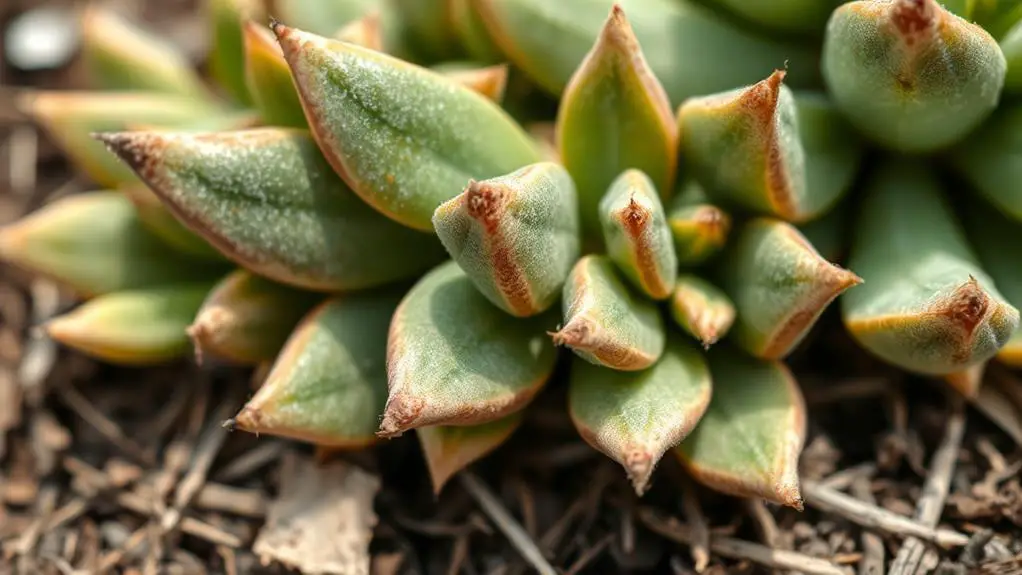
Allowing succulent leaves to callous is an important step in the propagation process that you shouldn't overlook. When you cut leaves from your succulent, it's essential to allow leaves to callous for about 3-7 days. This period is significant because it prevents water from entering the cut leaves, which can lead to rot.
During the callousing period, place the leaves on a paper towel or another dry surface. Make sure they're in a warm location with bright, indirect sunlight to help them heal.
The callousing process helps the leaf form a protective layer at the cut end, ensuring a healthy base for new growth. In humid environments, you might need to extend this period up to a week to make sure the cut ends dry sufficiently.
Patience is key here. A well-calloused leaf will have a much higher chance of successfully rooting and producing new plants.
Prepare Soil and Tray
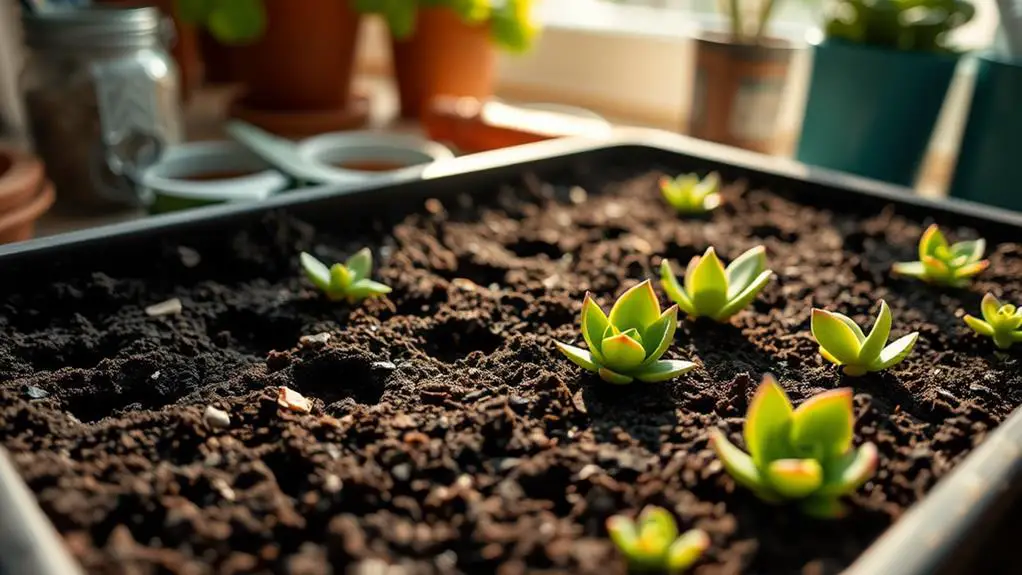
To guarantee successful propagation, start by preparing the soil and tray properly. First, you need to prepare soil that's lightweight and well-draining. This type of soil is vital for promoting healthy root development in your succulent leaf cuttings. Look for succulent or cactus soil, which works best.
Next, fill a shallow tray or container with a 2-inch layer of this prepared soil. The shallow tray allows for better air circulation, which supports the rooting process. Make sure the tray has drainage holes to prevent water accumulation. Excess water can lead to root rot, which is detrimental to your propagation efforts.
Once your soil is in the tray, moisten it evenly. This helps create a suitable environment for your leaf cuttings. Be careful not to soak the soil; just make it damp enough to support initial growth.
Also, avoid compacting the soil too tightly. Loose soil allows for better air circulation, which is necessary for the cuttings to root successfully.
Place Leaves on Soil
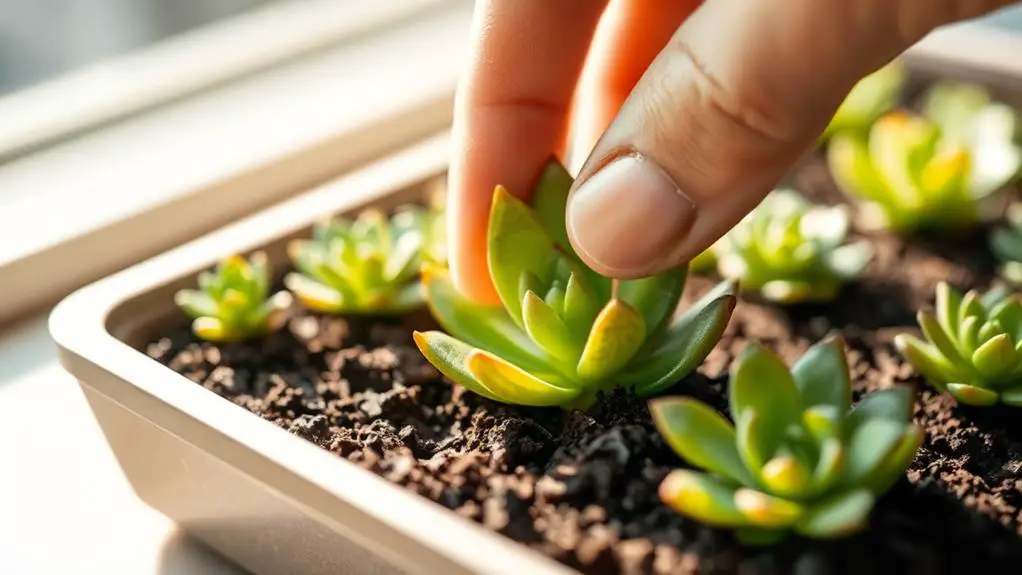
Now that your succulent leaves have calloused, place them on moist, well-draining soil, but don't bury them.
Keep the leaves' tops facing up to encourage photosynthesis and air access, helping roots develop.
Mist the soil lightly 2-4 times a week and place the tray in a warm spot with bright, indirect sunlight to see new roots and pups within 4-6 weeks.
Soil Moisture Maintenance
When placing succulent leaves on soil, make sure the calloused end rests on the surface without burying it, ensuring ideal air and light access for growth. To maintain soil moisture, water the soil 2-4 times weekly. This helps prevent overwatering and dehydration. Make sure you adjust your watering based on the temperature and humidity. Use a misting technique to keep the soil slightly damp. You don't want to soak the leaves, as excess moisture can lead to rot.
Position your tray or pot in a warm spot with bright indirect sunlight. Too much direct sunlight can scorch the leaves and hinder root development. Keep an eye on the leaves for signs of shriveling or blackening, as these can indicate problems with water levels or light exposure.
Here's a quick reference table to help you visualize:
| Task | Frequency | Notes |
|---|---|---|
| Watering | 2-4 times weekly | Adjust based on temperature |
| Misting | As needed | Keep soil damp, not soaked |
| Sunlight | Daily | Bright indirect sunlight preferred |
| Monitoring leaves | Every few days | Watch for shriveling or blackening |
| Adjusting conditions | As needed | Based on leaf and soil feedback |
Optimal Light Conditions
Maintaining the right soil moisture is only part of the equation; guaranteeing ideal light conditions is equally important for successful succulent leaf propagation.
Once you've placed the calloused leaves on well-draining succulent soil, it's time to focus on light. Position your tray or pot in a warm location that receives bright, indirect light. Remember, indirect light is best for these delicate leaves. Direct sunlight can scorch them, so be cautious.
To help your leaves grow evenly, rotate the tray periodically. This guarantees all leaves get equal light exposure, which is essential for even growth. If you notice the leaves stretching or becoming leggy, it's a sign they're not getting enough light. Monitor the light conditions carefully and adjust as needed.
Here's a quick guide to help you:
- Place in Warm Location: Guarantee the tray is in a warm spot with bright, indirect sunlight.
- Avoid Direct Sunlight: Direct sun can damage the leaves, so keep them out of harsh rays.
- Rotate Regularly: Rotate the tray to promote even growth and prevent stretching.
Root Development Timeline
After you've placed your calloused succulent leaves on moist soil, you'll need to exercise a bit of patience. Root development is a slow process, often taking 4 to 6 weeks. During this time, keep an eye out for signs of new growth. You might see tiny pups forming at the base of the leaves, a strong indicator that your propagating succulents are rooting successfully.
Ensure the soil stays slightly damp but not soggy. Overwatering can lead to rot, which can ruin your newly propagated plants before they even get a chance to establish roots. Only water when the soil dries out completely.
Bright indirect sunlight is essential during this period. It will help the leaves grow without scorching them. The exact time of year can also influence growth rates; warmer months tend to speed things up.
As you monitor progress, you'll notice the mother leaves starting to shrivel. This is a good sign. It means the pups are absorbing nutrients and are almost ready to be moved to a new pot.
Once they're strong enough, carefully transplant them, and they'll continue to thrive in their new environment.
Monitor Water and Light

How do you guarantee your succulent leaf cuttings thrive? Monitoring water and light is essential for successful propagation.
Start by keeping an eye on soil moisture. Water your leaf cuttings 2-4 times a week. Adjust the frequency based on temperature and humidity. You want the soil to stay slightly damp, but not soaking wet, to avoid rot.
Provide bright, indirect light to help your cuttings grow strong roots. Direct sunlight can scorch the leaves, harming their development. Consistent light exposure is important, as fluctuations can hinder root growth and overall health.
Here are three key steps to follow:
- Monitor Moisture: Check the soil daily. Mist if needed to maintain slight dampness. Avoid standing water around cuttings.
- Adjust Watering: Watch for signs of overwatering, like blackened or shriveled leaves. Cut back on watering if you notice these issues.
- Ensure Light Consistency: Place cuttings where they'll get bright, indirect light. Keep them away from direct sun to prevent scorching.
Transplant New Succulents
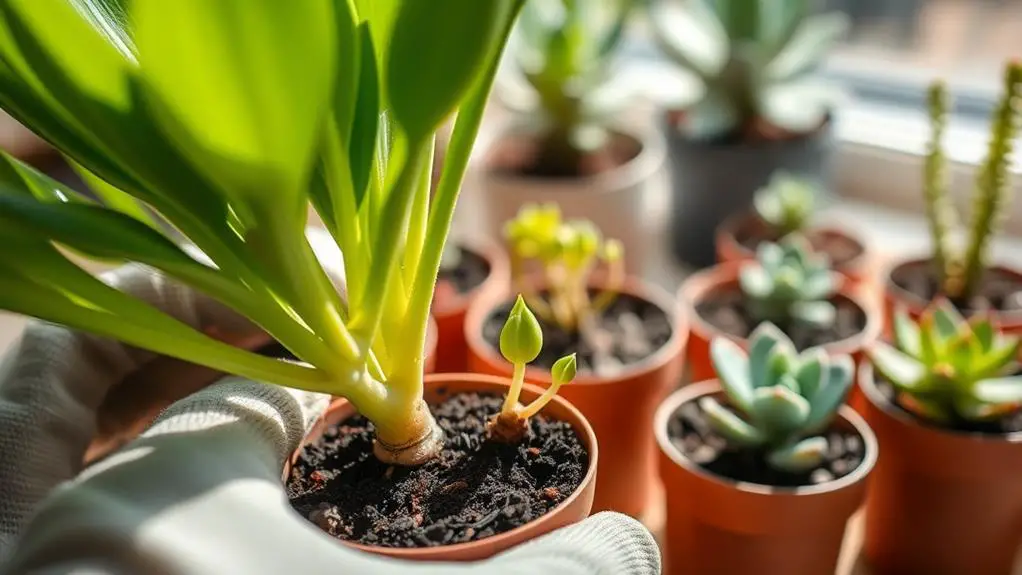
Transplanting your newly propagated succulents is an essential step in their growth journey. Once the roots are well-established, usually after 4-6 weeks, it's time to move them.
Start by checking that the mother leaf has shriveled and dried up, a sign that the new plantlets have their own roots.
Carefully remove the new succulents from the propagation tray. Be gentle to avoid damaging the delicate roots. Keep the roots moist during this process to reduce stress on the plants.
Transplant each succulent into a small pot, about 2 inches in diameter, with drainage holes. These holes guarantee healthy root growth by preventing water from sitting in the pot.
After transplanting, place your succulents in a spot with indirect bright light. Water them every two weeks, but adjust based on your environmental conditions to avoid overwatering.
Gradually introduce them to more sunlight over several days. This helps them acclimate and prevents sunburn.
Frequently Asked Questions
How Long Does It Take for Succulent Leaves to Propagate?
You'll need patience, as succulent leaves generally take 4-6 weeks to develop roots and tiny plants. Providing bright, indirect light and keeping the soil moist helps. Expect about a year for them to become fully established plants.
Should I Spray Water on My Succulent Leaves Every Day When Propagating?
No, don't spray water on your succulent leaves every day. Instead, mist the soil 2-4 times a week to keep it slightly damp. Adjust based on your environment, and always check for signs of dehydration or overwatering.
What Is the Fastest Way to Root Succulent Cuttings?
To root succulent cuttings quickly, use well-draining succulent soil, apply rooting hormone, and place them in a warm spot with bright, indirect light. Mist the soil regularly to keep it moist but not soaked.
Can You Put Succulent Cuttings Straight Into Soil?
You shouldn't put succulent cuttings straight into soil. Let the cut ends callous for 2-5 days first. This prevents rot and fungal infections, ensuring better root development when you eventually plant them in well-draining soil.
Conclusion
You've got all the steps to successfully propagate succulents from leaves. Just gather your tools, pick healthy leaves, and let them callous. Next, prepare your soil and place the leaves on top. Keep them moist and in bright, indirect light. Watch their progress, and once they grow roots, transplant them. Gradually introduce them to more sunlight. With patience and care, you'll soon have a thriving collection of new succulents. You've got this—happy growing!

